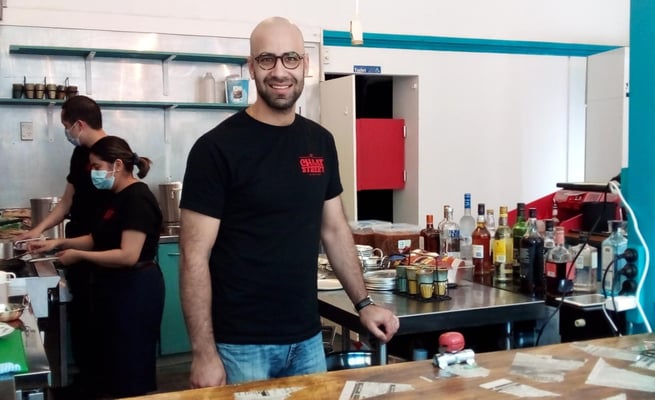Chat up a chaat at Welly’s Victoria Street

At a time when downtown Wellington is emerging as the graveyard for restaurants hit by Covid and the two-year border closure, a new outlet has sprung up on Victoria Street.
“Chaat Street” offers up Indian street food to the casual customer grown weary of the standard restaurant fare customised to suit the western palate.
Vaibhav Vishen, a former head chef of the Hilton and an alumnus of the Le Cordon Bleu (French) culinary arts school, in Wellington, wants to bring authenticity back to Indian cuisine. It is a word he dislikes, but it best describes his mission.
“Indian food in general has been bastardized in New Zealand,” he says. “The western palate is not used to spice, so adding sugar to Indian food became an accepted practice. Westerners now expect Indian curry to be sweet.”
This startling revelation is only one of many that pepper Vishen’s conversations on Indian cuisine. Vishen displays his encyclopedic knowledge of the subject whenever a customer cares to engage him.
The early immigrants to NZ, who forayed into the restaurant business but lacked the background or the know-how, served up compromised versions of Indian recipes to suit Kiwi tastes.
Vishen sets out to correct this distortion by taking Indian food as close as he can to its origins. “Chaat Street,” which opened last week, aims to include on its menu popular street foods drawn from different parts of India.
The customer is spoilt for choice, from Kashmiri kanti and chole bhature to idli and dosa and everything in between.
Why street food? “Sheer nostalgia,” pat comes the reply. Vishen came to NZ eight years ago and before long started craving the comfort foods he enjoyed while growing up in India. “I missed the joy of going up to a vendor and buying cotton candy,” he reminisces.
Indian street food goes back to the post-Mughal era, when disbanded royal chefs concentrated in the area around the Jama Masjid in Old Delhi. Karims is a famous brand name that traces its lineage back to that era.
Chaat, which is at the core of street food dating back to the post-Mughal period, relied on the Yamuna River as the source of water. Historically, salt was dumped into the stored river water to kill off microbes to make the water palatable. The high sodium content in chaat remains to this day.
Vishen says Indian food is community-centric and promotes the values of sharing and co-existence. “Indians do not like to eat as loners,” he observes.
Given its ethos, Indian street food does not sit well with western cutlery. Vishen encourages his customers to use their fingers while eating Indian food. “When a tiger goes out to hunt, it uses its claws, not a fork and knife,” Vishen quips, only partly in jest.
When he decided to start his own venture, Vishen’s location of choice was Cuba St, drawn by what he calls its “hipster chic.”
But Victoria St is just as cool, with its high footfall and young crowd. Plus, the business operates out of a heritage building, which fits in nicely with the style Vishen looks for.
The interior of Chaat Street looks markedly different from that of the up market, fine dining outlets in the neighborhood. It turns out the posh look is deliberately avoided. “We have retained the imperfections and mistakes in the structure,” Vishen explains.
“We have tried to give the restaurant the look of an old railway station in India,” he says, pointing to two turquoise-coloured pillars. “The British liked their greys and whites and pastels, while Indians like bright colours. So we turned our pillars into turquoise and red, which are the colours you see in Indian train stations today.”
The imperfect look is a strategic choice aimed at blending in with the wider environ. Victoria St is dotted with heritage structures, a fact not lost on Vishen.
But despite his strenuous efforts to return Indian food to its origins, Vishen believes Indian cuisine is not strictly Indian. It is a confluence of cross-cultural influences. “Goan food, for instance, is influenced by the Portuguese, Pondicherry cuisine by the French,” he explains.
Vishen is currently working on a book on Indian cuisine. He is tight-lipped about this project, but one thing is clear: Like Chaat Street, it will leave you with a flavour you will always remember.

At a time when downtown Wellington is emerging as the graveyard for restaurants hit by Covid and the two-year border closure, a new outlet has sprung up on Victoria Street.
“Chaat Street” offers up Indian street food to the casual customer grown weary of the standard restaurant fare customised to...
At a time when downtown Wellington is emerging as the graveyard for restaurants hit by Covid and the two-year border closure, a new outlet has sprung up on Victoria Street.
“Chaat Street” offers up Indian street food to the casual customer grown weary of the standard restaurant fare customised to suit the western palate.
Vaibhav Vishen, a former head chef of the Hilton and an alumnus of the Le Cordon Bleu (French) culinary arts school, in Wellington, wants to bring authenticity back to Indian cuisine. It is a word he dislikes, but it best describes his mission.
“Indian food in general has been bastardized in New Zealand,” he says. “The western palate is not used to spice, so adding sugar to Indian food became an accepted practice. Westerners now expect Indian curry to be sweet.”
This startling revelation is only one of many that pepper Vishen’s conversations on Indian cuisine. Vishen displays his encyclopedic knowledge of the subject whenever a customer cares to engage him.
The early immigrants to NZ, who forayed into the restaurant business but lacked the background or the know-how, served up compromised versions of Indian recipes to suit Kiwi tastes.
Vishen sets out to correct this distortion by taking Indian food as close as he can to its origins. “Chaat Street,” which opened last week, aims to include on its menu popular street foods drawn from different parts of India.
The customer is spoilt for choice, from Kashmiri kanti and chole bhature to idli and dosa and everything in between.
Why street food? “Sheer nostalgia,” pat comes the reply. Vishen came to NZ eight years ago and before long started craving the comfort foods he enjoyed while growing up in India. “I missed the joy of going up to a vendor and buying cotton candy,” he reminisces.
Indian street food goes back to the post-Mughal era, when disbanded royal chefs concentrated in the area around the Jama Masjid in Old Delhi. Karims is a famous brand name that traces its lineage back to that era.
Chaat, which is at the core of street food dating back to the post-Mughal period, relied on the Yamuna River as the source of water. Historically, salt was dumped into the stored river water to kill off microbes to make the water palatable. The high sodium content in chaat remains to this day.
Vishen says Indian food is community-centric and promotes the values of sharing and co-existence. “Indians do not like to eat as loners,” he observes.
Given its ethos, Indian street food does not sit well with western cutlery. Vishen encourages his customers to use their fingers while eating Indian food. “When a tiger goes out to hunt, it uses its claws, not a fork and knife,” Vishen quips, only partly in jest.
When he decided to start his own venture, Vishen’s location of choice was Cuba St, drawn by what he calls its “hipster chic.”
But Victoria St is just as cool, with its high footfall and young crowd. Plus, the business operates out of a heritage building, which fits in nicely with the style Vishen looks for.
The interior of Chaat Street looks markedly different from that of the up market, fine dining outlets in the neighborhood. It turns out the posh look is deliberately avoided. “We have retained the imperfections and mistakes in the structure,” Vishen explains.
“We have tried to give the restaurant the look of an old railway station in India,” he says, pointing to two turquoise-coloured pillars. “The British liked their greys and whites and pastels, while Indians like bright colours. So we turned our pillars into turquoise and red, which are the colours you see in Indian train stations today.”
The imperfect look is a strategic choice aimed at blending in with the wider environ. Victoria St is dotted with heritage structures, a fact not lost on Vishen.
But despite his strenuous efforts to return Indian food to its origins, Vishen believes Indian cuisine is not strictly Indian. It is a confluence of cross-cultural influences. “Goan food, for instance, is influenced by the Portuguese, Pondicherry cuisine by the French,” he explains.
Vishen is currently working on a book on Indian cuisine. He is tight-lipped about this project, but one thing is clear: Like Chaat Street, it will leave you with a flavour you will always remember.










Leave a Comment